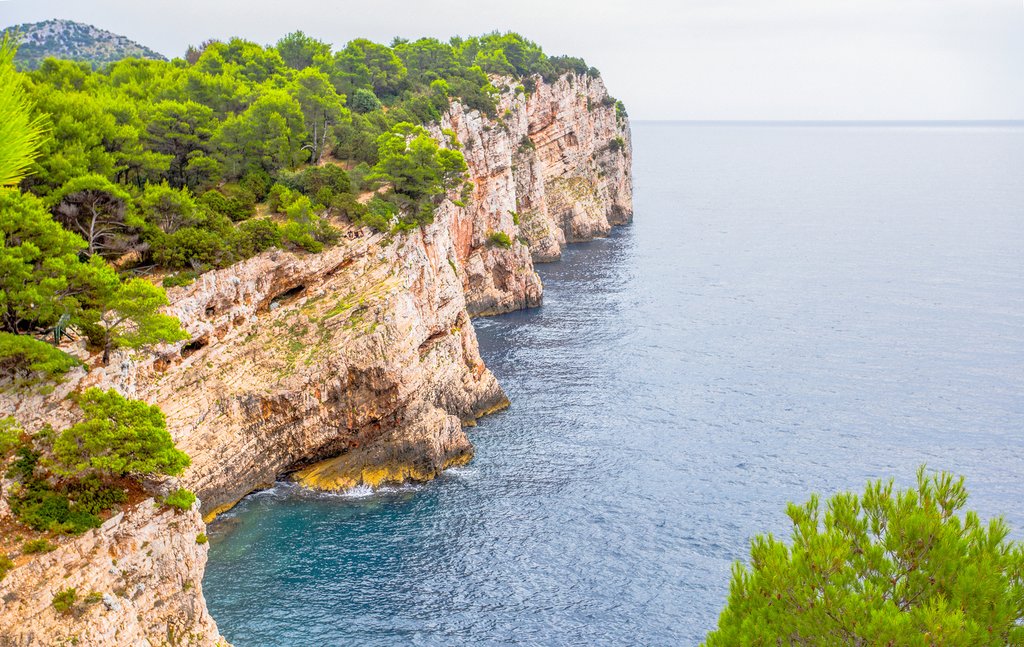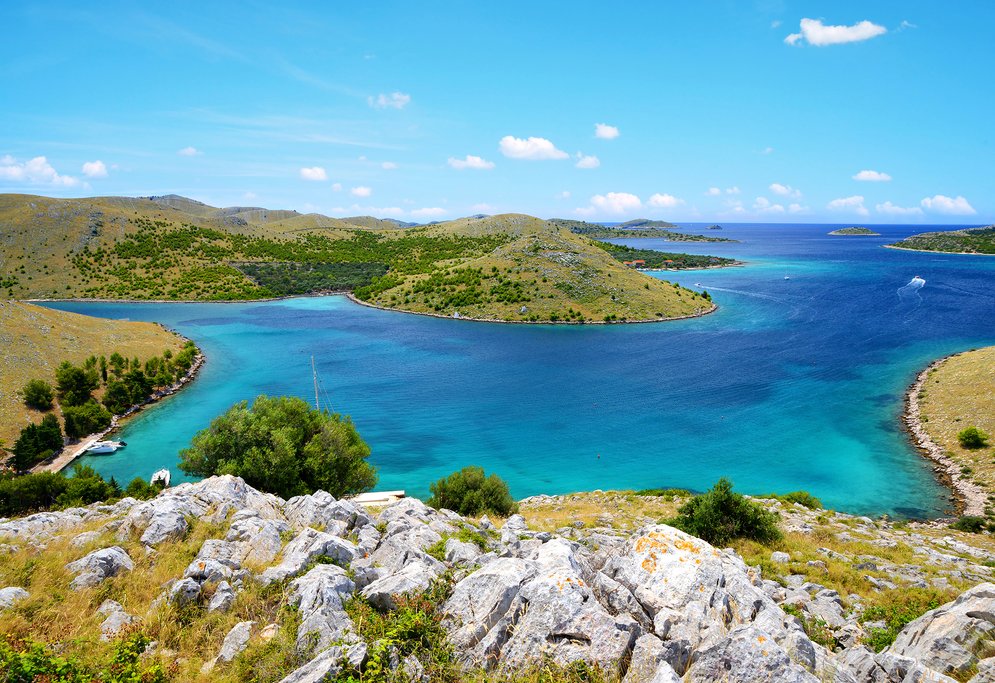Discover Kornati
Speckling the coast between Zadar and Šibenik, this trail of islands, islets, and reefs is split into two distinct halves: the Upper or Gornji Kornati and the Lower or Dornji Kornati, including the largest island of Kornat, from which the archipelago takes its name, the administrative island of Murter, connected to the mainland by bridge.
Some of them are eerily beautiful, desolate places, with a karst terrain full of caves, grottos, and cracks to explore, while others are home to vineyards, olive groves, and orchards that bring in a seasonal population of farmers to tend to them. What’s more, the long coastline of the island of Kornat creates a protected body of water for boats to sail in, allowing them to slalom through narrow channels between islands without heavy sea waves. The tranquil island waters have also created their own micro-climate underwater, as Adriatic marine life yields to rare species of algae, coral, and mollusks that makes for a unique swimming or snorkeling adventure.
Planning Your Trip

It should go without saying that you’ll need a boat to access Kornati. The relatively small area of the park (less than 13 miles squared) is countered by the sheer number of land masses, some of which are far too small to even be classified as true islands. Furthermore, because the islands are mostly uninhabited, you won’t be able to spend the night in a hotel there, meaning however far you’ll go, you’ll have to leave time for a return trip. But you have plenty of options when it comes to traveling by boat, including your own boat rentals, a private charter (sailboats or speedboats) with a captain who does the navigating for you so you can enjoy the sites, or even full-day kayaking adventures.
If you’re renting your own private boat, it means you’ll have the freedom to access the islands in any order you wish and even drop anchor and spend the night in one of the many bays and coves. If you plan on joining a tour, most last a full day (including lunch) and will take in several different islands. Your options may also be limited by your embarkation point (whether you’re setting off from Zadar, Šibenik, or somewhere along the coast in between).
In the high season (July and August), there are multiple tours per day, most of them in small boats that can accommodate groups. The high season will mean a greater number of people, though, so best to book in advance, especially if you have a few days along the coast and can choose the day you visit. Slightly fewer tours take place in the shoulder season (April to June, September to October) but you’ll also have fewer tourists to contend with.
Chat with a local specialist who can help organize your trip.
What to See and Do

The way you experience the Kornati Islands will largely depend on the kind of tour you take, but visitors to this archipelago can expect a mix of land and sea activities, taking advantage of the unique limestone-karst terrain and underwater eco-system.
A good first hike to try, thanks to its epic views over the entire archipelago, is up to the top of the Metlina or Opat peaks on the main island of Kornat. The islands’ sparse terrain means there is very little shelter, so start early in the morning, bring hats, water, and sunblock, and stop frequently for rests if it’s getting hot. On Mana and Klobučar, you can skirt along dramatic cliffs that rise directly from the ocean, taking in sharp, rugged terrain that was formed millions of years ago. If you’re especially into geology, two easy educational trails on the islands of Trtusa and Panitula will tell you about the natural and human history of the region.
There’s plenty of wildlife to see in the Kornati archipelago, but a lot of it is hard to spot. This includes reptiles (snakes and lizards) and birds (eagle owls, buzzards, peregrine falcons, kestrels). But the true attraction here is what goes on under the water, where brightly colored fish, moray eels, and crustaceans dart in and out of caves and grottos, among coral and sponges.
You can join up with a SCUBA excursion if you have your PADI certificate, or simply strap on goggles and a snorkel and view this wonderland from above as you float on the surface. Most dive companies adhere to strict Croatian guidelines and are located on the island of Murter. Of course, snorkeling is much easier, as it can be done on your own with very little gear, from a boat or from the beach.

Speaking of beaches, the Kornati islands are an ideal swimming destination, with a mix of sandy beaches on tranquil bays, and dramatic cliffs that are just low enough to be safe to jump off of, just high enough that you’ll still look like a daredevil when you do it. Better yet, thanks to the seclusion of the archipelago, you’ll never have to share your swimming spot with more than a handful of people. For the best swimming spots, check out Telascica and Saharun, pristine bays on the island of Dugi Otok, Lojena beach on the island of Levrnaka, or Opat, a large bay on Kornati with a restaurant and a boat dock.
If you’re looking to throw a bit of cultural heritage in with your outdoor time, the islands are speckled with ruins, including the remains of the ancient city of Colentum, at the foot of Mount Gradine at the Northern tip of Murter. Active during the reigns of Nero and Vespasian, the city was most likely destroyed in an earthquake in the 2nd Century AD. Today, it is an open-air archaeological park where you can wander, view signs with the ancient city’s layout, and check out coins and pottery found there. On Kornati, the Byzantine Fortress of Tureta leaves a bit more scope for the imagination, with its stone archway looking out to sea. A number of centuries-old churches scattered across the islands are also a testament Kornati’s enduring legacy.
Where to Stay

The fact that most of the Kornati islands are uninhabited means you’ll be fairly limited in your choice of places to stay. The island of Murter has several modest hotels and guesthouses, many of which also offer private tours to their guests, so you can book a room and an excursion to the islands at the same time. Aside from that, there are several regulated camping sites across the islands, many of them on Kornat and the adjoining Dugi Otok. If you have your own boat, there are 16 locations where you can drop anchor and spend the night in the park, listed on the official website.
Where to Eat
There aren’t too many restaurants in the Kornati archipelago, but what they lack in abundance they make up for with delicious, traditional dishes and a laid-back island ambience. Kornati has long been a breeding ground for sheep, so expect local lamb to be on the menu.
Of course, since you’re surrounded by water, you can also expect the fish and seafood to be just-caught, and prepared in simple ways that highlight rather than conceal their flavors (think grilling, fresh herbs, and local olive oil). Most restaurants are located on Murter, but you can also find a few on the more highly frequented beaches, including Opat and Telascica.
